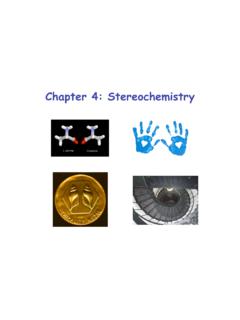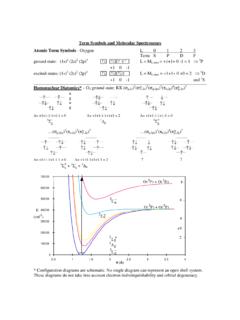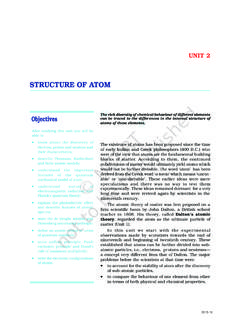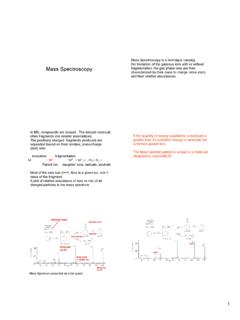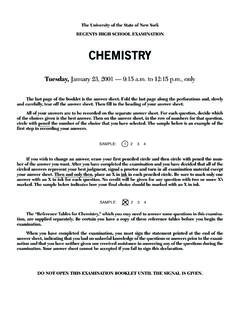Transcription of Introduction to Biochemistry - Colby College
1 C hapter 1. Introduction to Biochemistry Next time you're at the gym, think about the fact that all the cells in your body are working together to achieve your goals. Your muscles would rapidly fail without your liver sending out the sugar they need to contract. You could only last for a few minutes without your heart pumping oxygen-containing blood throughout your body. And without your brain sending signals to mastermind it all, you wouldn't even make it out of the locker room. One of the goals of this course is to understand how all the body's organs work together during exercise.
2 This is pretty complicated, as you can imagine, so before we can understand this cooperation between organs, we have to first discuss the building blocks of the organs, cells. We can reduce cells even further down to their components, the basic biological building blocks called lipids, carbohydrates, proteins, and nucleic acids. That's what Biochemistry is all about, trying to understand the whole from its parts. Chemistry Review If you were to take Biochemistry , you would first have to take a semester of introductory biology and four semesters of chemistry. However, our goal in this course is to learn just enough about Biochemistry to understand what's going on at the cellular level when we exercise.
3 Let's first highlight some of the most important concepts from all those chemistry courses that you (probably) haven't taken so that you can follow the rest of this chapter. A. What is chemistry anyway? Chemistry is the study of material substances and the changes they undergo. All materials are comprised of matter, which can be defined as anything that occupies space and has mass. Matter is composed of extremely small particles called atoms. There are about a hundred different kinds of atoms in nature. Each Exercise Physiology J. T. Millard Figure 1. different variety of atom is called an element, and chemists arrange these in the periodic table of the elements (Figure 1).
4 Not all the elements are represented equally, either on Earth itself or inside cells. All life forms are based on the element carbon (C), and they also contain relatively large amounts of hydrogen (H), nitrogen (N), oxygen (O), calcium (Ca), phosphorus (P), and sulfur (S). Atoms are made up of even smaller particles: positively charged protons, negatively charged electrons, and neutral neutrons. The arrangement of these subatomic particles puts the protons and neutrons together in a massive nucleus with the much smaller electrons buzzing around in a cloud. Atoms have equal numbers of protons and electrons, which means that the charges cancel and they are electrically neutral.
5 Atoms can link together in different ways to form molecules, with the glue . that holds them together called chemical bonds. Chemical bonds are often shared pairs of electrons. The arrangement of atoms in a molecule is called the structure, and chemists have developed some shorthand ways of representing structures. As an example, let's look at the molecule ethanol, which contains two atoms of carbon, six atoms of hydrogen, and one atom of oxygen. We can write a chemical 2. Exercise Physiology J. T. Millard formula for ethanol as C2H6O, where the subscripts reveal how many of each type of atom is in a molecule.
6 Usually, chemists would draw this molecule using a simple depiction with symbols for the atoms and lines for bonds (Figure 2C). This type of drawing can be further simplified by leaving out the explicit bonds between carbon and hydrogen, since there are so many carbon-hydrogen bonds in biological molecules (Figure 2D). B. Oxidation-Reduction Reactions Release Energy Chemical reactions occur when the atoms in molecules link up in new ways to produce new substances with different properties than the original materials, often releasing or consuming energy. Energy produced during chemical reactions can sometimes be harnessed to do useful work, such as lifting a big weight or throwing a ball.
7 An important type of chemical reaction in metabolism is the oxidation- reduction (or redox for short) reaction. Redox processes enable you to use the energy within fuel molecules and also provide the energy needed to power your Ipod and drive your car. Redox reactions involve the transfer of electrons from one substance to another. The substance that loses electrons is oxidized, while the substance that gains electrons is reduced. In reactions involving electron transfer there cannot be an oxidation without a reduction. Note that when an atom or molecule undergoes oxidation or reduction, it may end up with an unequal number of protons and electrons, thereby becoming a charged species called an ion.
8 3. Exercise Physiology J. T. Millard Figure Salt is made up of oppositely charged particles (ions) that attract each other. When salt is put into water, the ions separate and interact with water, becoming dissolved. This happens because each oxygen atom carries a slight negative charge and each hydrogen atom carries a slight positive charge- meaning that water is a polar molecule because of oxygen's greater ability to hold onto the shared pair of electrons. C. Like Dissolves Like Cells are pretty much tiny bags of salty water containing a lot of dissolved molecules and ions.
9 A mixture of water with dissolved substances is called an aqueous solution. The dissolved materials are called the solutes and the water is the solvent. Some materials clearly don't dissolve well in water. You've undoubtedly noticed that your salad dressing made up of oil-and-vinegar (which is mostly water). contains two distinct layers until you shake it up. The type of particles within a mixture dictates whether they will comingle on a molecular level or form distinct layers. When the particles interact with significant attractive forces, the result is a homogeneous mixture, with all particles comingled randomly on a molecular level to form a solution.
10 Water is composed of an oxygen atom and two hydrogen atoms. Oxygen has a stronger attraction for the shared pair of electrons than hydrogen, meaning that there is a partial negative charge on the oxygen and a partial positive charge on 4. Exercise Physiology J. T. Millard the hydrogen. Water is therefore a polar compound, meaning that it has a separation of electric charge. The types of materials that dissolve well in water are other molecules that have charge separation. Chemists summarize this phenomenon with the rule of thumb that like dissolves like. That is, because water is a very polar molecule, it dissolves other polar molecules and materials composed of ions, like salt (Figure ).




